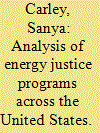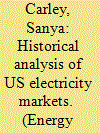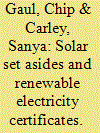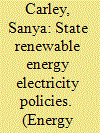|
|
|
Sort Order |
|
|
|
Items / Page
|
|
|
|
|
|
|
| Srl | Item |
| 1 |
ID:
180856


|
|
|
|
|
| Summary/Abstract |
The energy transition that is developing across the United States is producing both winners and losers. While some individuals, households and communities are reaping the benefits of the move toward cleaner, renewable sources of energy, others are experiencing its adverse effects, such as disruptions to labor markets, higher energy prices, and pollution and health burdens. To address these disparities, policymakers are increasingly calling for energy justice. However, there is scant scholarly literature on either the prevalence or characteristics of energy justice programs that already exist. Here we show that energy justice programs are both quite widespread and diverse across the United States, are most often led by nonprofit organizations rather than government agencies, and, while many share common missions, programs entail unique and often innovative strategies to achieve their objectives. The analysis lends important insights into current energy justice programs, but we argue deeper evaluation is necessary to identify which efforts are efficacious.
|
|
|
|
|
|
|
|
|
|
|
|
|
|
|
|
| 2 |
ID:
103623


|
|
|
|
|
| Publication |
2011.
|
| Summary/Abstract |
This paper evaluates whether the U.S. electricity sector is directed away from carbon-intensive technological lock-in, and which factors are contributing, or have potential to contribute, to a possible reorientation of the industry. With the application of a historical analysis of the electricity sector from the late nineteenth century through current day, this analysis finds that, although the industry still relies primarily on carbon-intensive fossil fuel operations, several recent trends indicate that the industry is becoming less carbon intensive, smaller in generation system scale, and more sustainable in operations. Crucial drivers-firm level interactions with technological change, industry leadership and market structure, government intervention and policy momentum, and citizen involvement and behavior patterns-that have traditionally shaped the structure, scale, and environmental footprint of the industry, have also played a prominent role in recent transformations. These results indicate that triggering or extraordinary events may not be necessary to initiate an escape from carbon lock-in in the electricity sector. Complete escape is not yet definitive, however, and it remains to be seen whether the industry is able to transform entirely before any significant climate change disturbances occur.
|
|
|
|
|
|
|
|
|
|
|
|
|
|
|
|
| 3 |
ID:
115144


|
|
|
|
|
| Publication |
2012.
|
| Summary/Abstract |
This paper assesses the market developments in North Carolina's solar energy industry following the state's adoption of a renewable portfolio standard (RPS). It first reviews how solar renewable electricity certificates (SRECs) are intended to act as a support mechanism for the installation and financing of solar power in North Carolina's RPS compliance market. The paper then analyzes why SRECs have not precipitated growth in the solar industry thus far. Instead of attracting a diversity of solar installation and SREC trading businesses to create a competitive market to North Carolina, the RPS has only enabled a few large solar power producers to compete with utility companies to finance, install, and operate solar generating systems. A comparison between the SREC markets in North Carolina, Pennsylvania, and New Jersey reveals that transparency in prices and volumes of SRECs, limits on utility company self-ownership of solar generators, and more aggressive solar set-aside targets are required to create a competitive market environment that will attract a sustainable and growing solar industry.
|
|
|
|
|
|
|
|
|
|
|
|
|
|
|
|
| 4 |
ID:
088975


|
|
|
|
|
| Publication |
2009.
|
| Summary/Abstract |
Over the past decade, state governments have emerged as US energy policy leaders. Across the country, states are adopting policy instruments aimed at carbon mitigation and renewable energy deployment. One of the most prevalent and innovative policy instruments is a renewable portfolio standard (RPS), which seeks to increase the share of renewable energy electrification in the electricity market. This analysis evaluates the effectiveness of state energy programs with an empirical investigation of the linkage between state RPS policy implementation and the percentage of renewable energy electricity generation across states. We use a variant of a standard fixed effects model, referred to as a fixed effects vector decomposition, with state-level data from 1998 to 2006. Results indicate that RPS implementation is not a significant predictor of the percentage of renewable energy generation out of the total generation mix, yet for each additional year that a state has an RPS policy, they are found to increase the total amount of renewable energy generation. These findings reveal a potentially significant shortcoming of RPS policies. Political institutions, natural resource endowments, deregulation, gross state product per capita, electricity use per person, electricity price, and the presence of regional RPS policies are also found to be significantly related to renewable energy deployment.
|
|
|
|
|
|
|
|
|
|
|
|
|
|
|
|
|
|
|
|
|